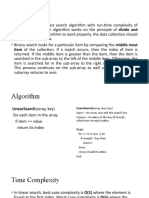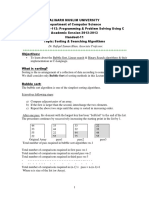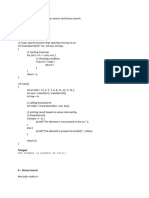0% found this document useful (0 votes)
68 views24 pagesUnit V - Searching and Sorting
The document discusses searching algorithms, specifically Linear and Binary Search, providing algorithms and C programs for both. It also covers sorting algorithms including Bubble Sort, Selection Sort, and Insertion Sort, detailing their workings, pseudocode, and C implementations. The time complexities for these algorithms are highlighted, with Linear Search being O(n), Binary Search O(log n), and the sorting algorithms O(n^2).
Uploaded by
kothitarun130301Copyright
© © All Rights Reserved
We take content rights seriously. If you suspect this is your content, claim it here.
Available Formats
Download as DOCX, PDF, TXT or read online on Scribd
0% found this document useful (0 votes)
68 views24 pagesUnit V - Searching and Sorting
The document discusses searching algorithms, specifically Linear and Binary Search, providing algorithms and C programs for both. It also covers sorting algorithms including Bubble Sort, Selection Sort, and Insertion Sort, detailing their workings, pseudocode, and C implementations. The time complexities for these algorithms are highlighted, with Linear Search being O(n), Binary Search O(log n), and the sorting algorithms O(n^2).
Uploaded by
kothitarun130301Copyright
© © All Rights Reserved
We take content rights seriously. If you suspect this is your content, claim it here.
Available Formats
Download as DOCX, PDF, TXT or read online on Scribd
/ 24






















































































